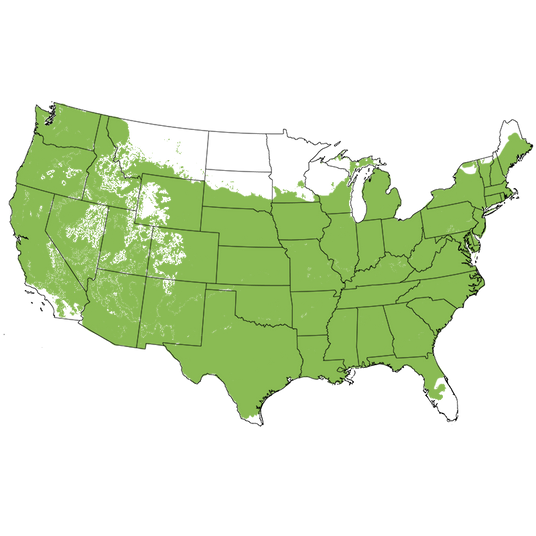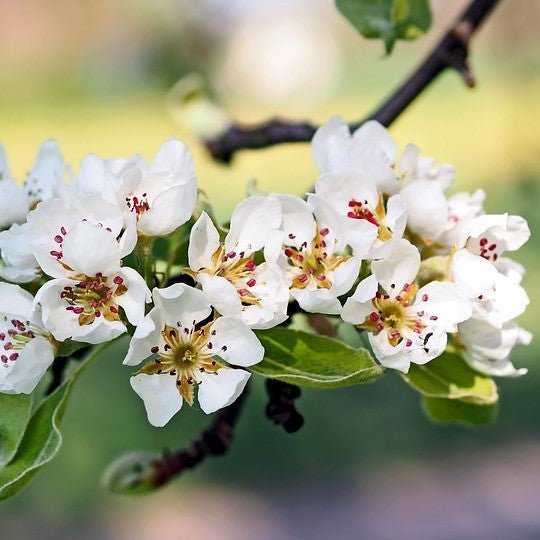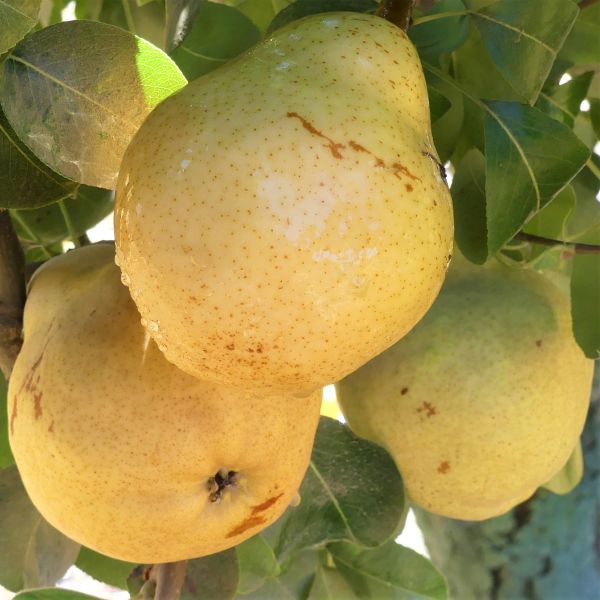Bartlett Pear Tree
Pyrus communis 'Bartlett'
Plant Sentry™
Plant Sentry™

Plant Sentry™ Protected
Your order is protected by our compliance system that:
- Prevents restricted plants from shipping to your state
- Ensures plants meet your state's agricultural requirements
- Protects gardens from invasive pests and diseases
Delivery and Shipping
Delivery and Shipping
Delivery and Shipping
Fast, Safe Plant Delivery
Ships in 3-4 business days • Tracking provided • Weather protected
| Under $50 | $9.99 |
| $50 - $99.99 | $14.99 |
| $100 - $149.99 | $16.99 |
| $150 - $198.99 | $24.99 |
| $199+ | FREE |
✓ Zone-specific timing • ✓ Professional packaging • ✓ Health guarantee
Understanding Plant Options
Nature Hills offers plants in two main formats:
- Container Plants: Grown in pots with soil, sized by container volume and plant age
- Bare Root Plants: Dormant plants without soil, sized by height measurements
Container Plant Sizes
Container sizes indicate plant age and growing capacity rather than liquid volume equivalents. Our containers follow industry-standard nursery "trade gallon" specifications, which differ from standard liquid gallon measurements.
Young Plants (6 months to 18 months old)
| Container Size | Actual Volume | Metric Equivalent |
|---|---|---|
| 2" x 2" x 3" | 0.18 - 0.21 dry quarts | 0.20 - 0.23 dry liters |
| 4" Container | 0.31 - 0.87 dry quarts | 0.35 - 0.96 dry liters |
| 4.5" Container | 0.65 dry quarts | 0.72 dry liters |
| 6" Container | 1.4 dry quarts | 1.59 dry liters |
| 1 Quart | 1 dry quart | 1.1 dry liters |
| 5.5" Container | 1.89 dry quarts | 2.08 dry liters |
Established Plants (18 months to 2.5 years old)
| Container Size | Actual Volume | Metric Equivalent |
|---|---|---|
| 2 Quart | 2 dry quarts | 2.2 dry liters |
| #1 Container | 2.26 - 3.73 dry quarts | 2.49 - 4.11 dry liters |
| 5" x 5" x 12" | 3.5 - 4.3 dry quarts | 3.85 - 4.74 dry liters |
Mature Plants (2-4 years old)
| Container Size | Actual Volume | Metric Equivalent |
|---|---|---|
| #2 Container | 1.19 - 1.76 dry gallons | 5.24 - 7.75 dry liters |
| #3 Container | 2.15 - 2.76 dry gallons | 8.14 - 12.16 dry liters |
Large Plants (3-5 years old)
| Container Size | Actual Volume | Metric Equivalent |
|---|---|---|
| #5 Container | 2.92 - 4.62 dry gallons | 12.86 - 20.35 dry liters |
| #6 Container | 5.25 - 6.01 dry gallons | 23.12 - 26.42 dry liters |
| #7 Container | 5.98 - 6.53 dry gallons | 26.34 - 28.76 dry liters |
Bare Root Plants
Bare root plants are sold by height from the root system to the top of the plant. Plants may exceed minimum height requirements.
Common Sizes:
- Trees: 1 foot, 2 feet, 3 feet, 4 feet, 5 feet, 6 feet
- Shrubs & Perennials: 1 foot, 18 inches, 2 feet
Important Notes
Container Volume Specifications
- Trade Gallon Standard: Our containers follow industry-standard "trade gallon" specifications established by the American National Standards Institute (ANSI Z60.1) for nursery stock
- Volume Variations: Actual soil volume may vary due to plant root systems and growing medium settlement
- Age Indicators: Container size primarily indicates plant age and maturity rather than liquid volume equivalents
Growing Conditions
- Plant size can vary based on variety and growing conditions
- Container size helps indicate plant maturity and establishment level
- Larger containers generally mean more established root systems and faster landscape establishment
Seasonal Availability
- Bare root plants are available seasonally when dormant
- Container plants are available throughout the growing season
- Specific varieties may have limited availability in certain sizes
Questions?
For questions about specific plant sizes or availability, please contact our plant experts who can help you choose the right size for your landscape needs.

Plant Sentry™ Protected
Your order is protected by our compliance system that:
- Prevents restricted plants from shipping to your state
- Ensures plants meet your state's agricultural requirements
- Protects gardens from invasive pests and diseases
Plant Profile & Growing Essentials
Cold hardy, Self-pollinating, Flowering, Edible, Ornamental Berries/Fruit, Attracts pollinators, and Thornless
Specifications
Specifications
-
Botanical Name
-
Height
-
Width
-
Growing Zones
-
Sunlight
-
Growth RateModerate
-
Flower Color
-
Leaf Color
-
Pollinator FriendlyYes
-
Pollinator Required
-
Harvest Time
-
FragrantYes
-
Bloom PeriodLate Spring
-
Does Not Ship ToAK, HI, ID, MT, OR
Planting & Care Instructions
Planting & Care Instructions
Long-Lived World Famous Favorite Bartlett Pear Tree!
- Golden Green Skin Ripens Golden Yellow
- Delicious Sweet & Juicy
- Crisp White Flesh Perfect for Fresh Eating, Cooking & Baking
- Ornamental Year-Round
- Gorgeous Clusters of White Blooms
- Handsome Green Foliage
- Vigorous Growing Small Tree
- Long-Lived
- Urban Condition Tolerant
- Pollinates with Bosc, D’Anjou or Comice!
- Keeps Well In Storage
- Heirloom Antique Variety
- 800 Chill Hours
Also known as Williams' pear in Europe, the Bartlett is one of the most popular pears in the world. Its origins could go as far back as the late 1400s, making this amazing tree a classic favorite. Its exceptional fruit and overall heartiness makes it a favorite for experienced gardeners and amateurs alike.
Nothing quite compares to the Bartlett Pear. Produced from a deciduous tree with ornamental features, the Bartlett Pear (Pyrus communis 'Bartlett') is delicious, juicy, and oh-so-sweet.
Clusters of tiny white blossoms emerge from the Bartlett Pear tree during early spring! Fragrant and buzzing with bees and aflutter with butterflies, you may even see a hummingbird or two!
Bartlett Pears grow to have a rounded bell shape and green skin that turns golden yellow as it ripens. The white flesh holds juicy sweetness and is a crisp favorite to use for cooking and baking. Of course, it is perfect for fresh eating too!
How exciting to pluck one of the delicious pears from your very own tree! You’ll know exactly what went into (and onto) the fruit you’re providing for your family! Plus, there’s nothing quite like a fresh pear, sun-ripened and straight off the branch! That grocery store fruit just can’t hold a candle to it!
How to Use Bartlett Pear Tree In The Landscape
Because this European Pear variety is considered only self-fruitful when grown in zone 9 on the coast of CA, you'll get a larger harvest if you plant with another of Bartlett’s cross pollinators nearby so most of us will need to plant one of the suggested pollinators for this plant like Bosc Comice, Warren, D'Anjou, Hosui, Korean Giant, Shinshiki, or Red Clapp's Favorite.
The Bartlett pear is a beautiful tree with exceptional fruit. The fruit keeps well in storage and is prized for use in preserves, tarts and other dishes. Of course, it also tastes great right off the tree!
Smaller size means about any yard, orchard or courtyard has room for a Bartlett Pear! Use as a specimen plant in your front landscaping for a dual-purpose flowering tree. No room for Bartlett and one of its pollinators? Try this high-density planting trick in our Garden Blog!
Add to an existing landscape or orchard easily because Bartlett is pruned smaller as needed. Keep it short for easy harvest and to fit into any established garden.
Create a hedgerow of fruit trees for privacy, screening and property definition by planting this and other smaller trees in a row!
When left to grow to full height, Bartlett creates fantastic shade for your patio, seating areas and garden beds!
#ProPlantTips For Care
Bartlett Pear trees are vigorously growing and precocious, meaning you won't have to wait long for your first harvest. The tree also is generally long-lived.
Fruit trees require full sun for the most vigorous growth and best harvest. Provide at least 6 hours of sunlight per day, favoring the drying power of the morning sun. Hardy in USDA growing zones 4 through 9, these are cold and heat-hardy trees!
Be sure to plant trees in rich, fertile well-drained soil, be sure to add a generous layer of mulch to help retain soil moisture as well as insulate the root system from heat and chill.
Provide ample water for your young tree while it becomes established, not allowing it to dry out between waterings. Then reduce your watering to moderate, yet consistent moisture during the heat of summer and when fruiting. While drought-tolerant, it’s best to protect your investment by providing supplemental watering in times of need.
Situate in an area that is protected from frost pockets and with good air circulation. Prune to keep an open canopy so that both sunlight and airflow reach the interior. Head over to our Garden Blog for more Fruit Tree Planting, Fruit Tree Pruning and Fruit Tree Care tips and tricks can be found!
Bartlett is versatile, faring well in agricultural, suburban and urban environments. Urban pollution doesn't seem to be a problem for this amazing fruit tree.
This is an outstanding choice for a lovely tree that also provides an ample harvest! Order these healthy Bartlett Pear Trees with extensive root systems, and get a head start on your next crop by placing your order with NatureHills.com today!
Bartlett Pear Tree Frequently Asked Questions
How long does it take for Bartlett Pear Trees to bear fruit?
Nature Hills Nursery sells fruit trees with mature root systems, and will often set fruit in their second or third years.
How Fast Do Bartlett Pear Trees Grow?
Pear trees are moderate growth rate plants and can add 12-18 inches and more per year in optimal conditions once they have established.
Where do Bartlett Pear Trees Grow Best?
Pear trees grow best in well-drained, fertile soil in at least 6 hours of full sun per day or more.
Do You Need 2 Pear Trees to Produce Fruit?
All Pyrus varieties have different requirements to set fruit. While a few varieties are self-fertile but will always have a larger harvest with a pollination partner. Bartlett (Pyrus communis 'Bartlett') is not self-fruiting and needs a pollinating partner. Pair with one of these varieties:
No room? Look into High-Density Planting techniques, or choose a semi-dwarf or dwarf fruit tree.
When Should Bartlett Pear Trees be Planted?
Bareroot Pear trees are best planted in the spring but container-grown Pear trees can be successfully transplanted all throughout the growing season as long as the ground isn’t frozen and they are carefully watered as needed. Check for first and last frost dates for your area with your local County Extension Office.
Harvest Times for Bartlett Pears
Bartlett pears are typically ready to harvest in August.
How Do I Find Bartlett Pear Trees for Sale Near Me?
Make your life easier and your yard happier by shopping for Pear trees at NatureHills.com online fruit tree nursery. You’ll find a massive selection of fruit trees for sale, including many lovely Pear tree varieties!
Choose the right tree for your area by first finding your growing zone by entering your zip code in the field above the Plant Highlights section on our product pages. Narrow down your options by plant hardiness zone, sun availability, and size requirements.
Place your order, knowing it’s backed by the Nature Hills Nursery product guarantee and protected by Plant Sentry™, which helps ensure regulated plant materials aren’t sent to prohibited areas.
Expect to receive your plants at the appropriate planting time for your growing zone when temperatures are safest.
What shipping options do you offer?
NatureHills.com works closely with our growers and nursery professionals to ensure we ship when it is most appropriate for your area. Our goal is to deliver the hardiest plants by avoiding extreme high and low temperatures. Check out our shipping schedule for more information and to learn our wills and won’ts when it comes to shipping plants. Find your Bartlett Pear Tree for sale here at NatureHills.com!
Twisting, Turning Story of a Beloved Pear Variety
The Bartlett Pear is worldwide and one of the most popular pears grown. But did you know that you can only purchase the Bartlett Pear in the United States and Canada?
It seems that the origin of the Bartlett, by some accounts, could date back as far as the late 1400's. In the pedigree of names associated with the Bartlett, "Bon Chretien" (Good Christian) is named first. It is associated with a Holy-man, Francis of Paola, who gave seeds of a pear variety to King Louis XI.
Some undefined lineage traces this offering next to an English schoolmaster, Mr. Wheeler in Aldermaston, England, in the late 1760's. A Mr. Stairs acquired the Wheeler property and was excited to find seedling pears growing in the garden. This is likely the reason why there is reference to the variety being known as the Aldermaster pear, or the Stair Pear.
Stairs sent off cuttings to Richard Williams, a Nurseryman in Turnham Green, England in the early 1800's. Williams then introduced the pear as The Williams Pear, in 1814.
A James Carter then imported the Williams Pear to Roxbury, Massachusetts in 1799. The trees were planted on the estate of Thomas Brewer, which was later purchased by Enoch Bartlett.
Bartlett had no idea of where this variety came from and introduces the variety as the Bartlett Pear. It quickly gained widespread attention and became a standard for pears in the United States.
It is reported that in 1828, the Williams Pear tree variety arrived from Europe. It was soon thereafter they realized that Bartlett and Williams are the same variety.
This was too late for the already established Bartlett to have a name change. This story may have been repeated many times throughout the world as there are reports of the Williams Pear under many different names around the world.













